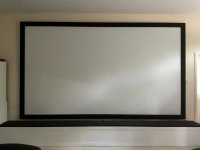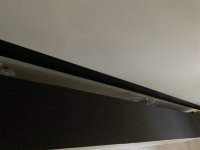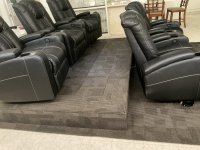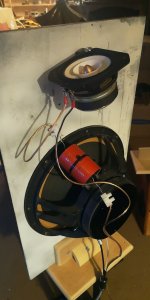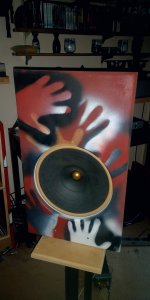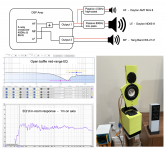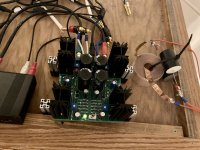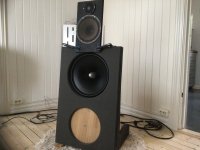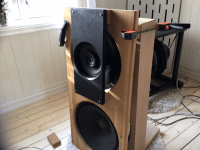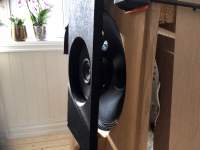Probably a bit strange, but this is my open baffle soundbar (and HT screen: 175" Silver Ticket Screen). This "bar" (though there are actually 2 sections with one section at the rear with the tweeters) is about 14ft wide (slightly wider than the nearly 13 feet of Screen). The "bar" is also almost 20"s high, and is open to the rear with cloth draping it. Further, the "bar" has 3 channels (left, center, and right) with each channel composed of 1 - 1.5" cone tweeter, 4 - 4" fullrange drivers up-firing, and 1" 10 pro woofer up-firing. Due to the "up-firing" orientation this is the only design I've ever seen that is both radial AND open baffle (though obviously the tweeters are "nude" dipoles). The left and right tweeters have some cotton rebond insulation covering most of their front output - this was done to decrease the output close to the near seats for each channel while still having good spl/output for the far channel (..in other words: so the person in the left seat wasn't hearing a great deal of left channel and the person in the right seat wasn't hearing mostly right channel). Sadly I still haven't gotten around to the tweeter "bar's" covering nor have I placed a curtain around the screen to limit light-bleed to the cabinet to the left, ceiling, etc..
(..and yes, I screwed up with the build in a few places, particularly the molding at the bottom and the joint spanning the front panel of the "bar". Still, it's been quite serviceable over the past few years.)
Still, it's been quite serviceable over the past few years.)
(..and yes, I screwed up with the build in a few places, particularly the molding at the bottom and the joint spanning the front panel of the "bar".
 Still, it's been quite serviceable over the past few years.)
Still, it's been quite serviceable over the past few years.)Attachments
Last edited:
Also open baffle and again with some uncommon design elements, the 3-chair back-row platform is an open baffle subwoofer. There are two "slot" openings on the "front" and rear of the platform with rectangular "grill cloths". It's basically an "H" frame design (separating the phase difference between the woofers) that's coupled to the floor (through the sheer weight of cabinet and the chairs on it). There are *two 15" high "Q" woofers that are down-firing and "slot loaded" into a larger front chamber (the frontal part of the "H") with the rear out-of-phase open to it's side of the "H" frame.
*it should have been at least 4 woofers (and preferably 8), as it is - the woofers can still bottom out if I'm not careful with the sub-setting for the particular movie.
The platform is specifically designed to shake with loud bass transients.
Perhaps even more different than most designs, the rug-like platform (that has the two front recliners on it) has 2 **bass shakers and is also coupled to the floor in such a way that it shakes as well. (Note that structurally this rug-like extension of the platform is physically separate from the 2nd row platform, basically that 8" high second row platform/"H"frame/box is one piece and the rest of the rug including the surrounding edge is a different piece.)
**that little black puck you see under the right front recliner.
Finally (and most importantly), each recliner has 2 bass shakers installed - one in the lumbar area and one at the bass of the chair for the chair's bottom. This is actually more important than the subwoofer as it generates the sensation of bass even though it isn't something you hear (which is strange but true). Turning off the shakers while keeping the sub on is far less beneficial than having the bass shakers on and the subwoofer off - and I don't mean this as simply a tactile sensation, I mean this in regard to its "audible" character. Note: this is with the front "soundbar" having a 100 Hz high-pass from the receiver.
The subwoofer's most notable improvement is with respect to certain scenes having low-freq "hall-sound" that represents expansion of the audible space.
The net result is something that sounds far more like a movie theater than a home theater while ALSO having the physical impact that very few commercial movie theaters have. (..most large commercial movie theaters don't have that "boomy" character that almost all HT's have, because of course the room dimensions are so large that the modes are so low in freq.. This home theater is very much like a large commercial movie theater in this respect. It's also more like one with respect to the size of the screen and the placement of the chairs/viewing position - and this makes a (literal) HUGE difference.)
Note: This system even at fairly high listening levels with (literally) explosive transients is barely audible to the rest of the home despite being relatively near the adjoining family room.
*it should have been at least 4 woofers (and preferably 8), as it is - the woofers can still bottom out if I'm not careful with the sub-setting for the particular movie.
The platform is specifically designed to shake with loud bass transients.
Perhaps even more different than most designs, the rug-like platform (that has the two front recliners on it) has 2 **bass shakers and is also coupled to the floor in such a way that it shakes as well. (Note that structurally this rug-like extension of the platform is physically separate from the 2nd row platform, basically that 8" high second row platform/"H"frame/box is one piece and the rest of the rug including the surrounding edge is a different piece.)
**that little black puck you see under the right front recliner.
Finally (and most importantly), each recliner has 2 bass shakers installed - one in the lumbar area and one at the bass of the chair for the chair's bottom. This is actually more important than the subwoofer as it generates the sensation of bass even though it isn't something you hear (which is strange but true). Turning off the shakers while keeping the sub on is far less beneficial than having the bass shakers on and the subwoofer off - and I don't mean this as simply a tactile sensation, I mean this in regard to its "audible" character. Note: this is with the front "soundbar" having a 100 Hz high-pass from the receiver.
The subwoofer's most notable improvement is with respect to certain scenes having low-freq "hall-sound" that represents expansion of the audible space.
The net result is something that sounds far more like a movie theater than a home theater while ALSO having the physical impact that very few commercial movie theaters have. (..most large commercial movie theaters don't have that "boomy" character that almost all HT's have, because of course the room dimensions are so large that the modes are so low in freq.. This home theater is very much like a large commercial movie theater in this respect. It's also more like one with respect to the size of the screen and the placement of the chairs/viewing position - and this makes a (literal) HUGE difference.)
Note: This system even at fairly high listening levels with (literally) explosive transients is barely audible to the rest of the home despite being relatively near the adjoining family room.
Attachments
Last edited:
My latest hopefully last redux of these 12 inch full rangers. They rely on using the baffle as a highpass to meet the sub, which is lowpassed at a high 100 hertz 4th order slope.
It's a little rough, as everything was made from spare parts, but I like them.
The bit of extra centre fill from the angled 4 inch drivers ceiling reflections is subtle and welcome.
Crazy good for my 2.1 channel music and home theatre system.
Not as illusory at throwing sound effects around as the horn hybrid dipoles were, but I have no sense of loss from no surrounds.
It's a little rough, as everything was made from spare parts, but I like them.
The bit of extra centre fill from the angled 4 inch drivers ceiling reflections is subtle and welcome.
Crazy good for my 2.1 channel music and home theatre system.
Not as illusory at throwing sound effects around as the horn hybrid dipoles were, but I have no sense of loss from no surrounds.
Attachments
I've always been interested in upward firing drivers. Audio kinesis had some very interesting models that utilised that technique a lot but quite a bit more sophisticated.My latest hopefully last redux of these 12 inch full rangers. They rely on using the baffle as a highpass to meet the sub, which is lowpassed at a high 100 hertz 4th order slope.
It's a little rough, as everything was made from spare parts, but I like them.
The bit of extra centre fill from the angled 4 inch drivers ceiling reflections is subtle and welcome.
Crazy good for my 2.1 channel music and home theatre system.
Not as illusory at throwing sound effects around as the horn hybrid dipoles were, but I have no sense of loss from no surrounds.
I've tried them and they sound more bi-pole than di-pole to me. Ever since the OB bug bite, my mind "wants" dipole; the sound radiating backward must be 180 deg out of phase or "something's not quite right".I've always been interested in upward firing drivers
I'm sure if I built castles with one front, one up firing and listened to them for a couple years - anything else would sound a bit off too...
I have since removed the upfiring drivers. Today I started making some U Frame bass bins/satellite stands, with dual ten inch woofers. At this point I'm planning top and bottom plates, with one wing.I've tried them and they sound more bi-pole than di-pole to me. Ever since the OB bug bite, my mind "wants" dipole; the sound radiating backward must be 180 deg out of phase or "something's not quite right".
I'm sure if I built castles with one front, one up firing and listened to them for a couple years - anything else would sound a bit off too...
Adding a shallow wing and a top plate to the satellites makes them fine for late night listening, or adding a sub at 70 hertz.
I haven't heard open backed bass with these drivers for years, and a full U Frame was done wrong last time, making a cavity resonance that needed to be EQ'd out.
Here they'll be bandwidth limited enough to just use the plate amp filter to add some heft without neighbour disturbing bottom octave bass.
My Linkwitz inspired micro open baffle, a work in progress.
Only the 3 inch Tang Band midrange is open baffle, but it covers 400Hz to 8kHz. It's a three way driven with 2 channels of a DSP amp with a hybrid crossover. +13dB of boost on the midrange at 400Hz. Mini AMT tweeter
Only the 3 inch Tang Band midrange is open baffle, but it covers 400Hz to 8kHz. It's a three way driven with 2 channels of a DSP amp with a hybrid crossover. +13dB of boost on the midrange at 400Hz. Mini AMT tweeter
Attachments
Very nice looking! I'm interested in hearing why you picked the Dayton ND55-8 as the LF driver. At 2 1/2" its tiny and has a Fs of 77.4Hz and a sensitivity of 80.8dB @ 2.83V/1mMy Linkwitz inspired micro open baffle, a work in progress.
Only the 3 inch Tang Band midrange is open baffle, but it covers 400Hz to 8kHz. It's a three way driven with 2 channels of a DSP amp with a hybrid crossover. +13dB of boost on the midrange at 400Hz. Mini AMT tweeter
Very nice looking! I'm interested in hearing why you picked the Dayton ND55-8 as the LF driver. At 2 1/2" its tiny and has a Fs of 77.4Hz and a sensitivity of 80.8dB @ 2.83V/1m
Lol, I'll admit, it is not the obvious choice. To tell the truth, just because I already had one sitting in a suitable enclosure, and it was easy enough to print up another one. This was mainly an experiment with what I had to hand. The Mini AMT's were the only drivers I bought specifically for it.
Honestly the ND65's sound remarkably good for what they are. They are BR tuned to 65Hz, and will play at reasonable levels at 2m without feeling too strained. I defy anyone not the be surprised but what they can put out.
Anyway, I'm looking to do an upgrade of the setup. I'm thinking perhaps a W5-2143 dipole mid, GRS PT2522-4 dipole HF, ND91-4 sealed LF. I'm hoping with that I might drop the LF/MF crossover to ~200Hz and keep with the small baffle config.
Been using this setup for a while, I don't have any measuring equipment so don't know how accurate it is but to be honest I don't really care !! It sound good enough to me.

Plan coming together. My current speakers were planned as having a small folded open baffle taking on the role of a highpass filter to a midrange coupler and subwoofer.
It just missed, and I wound up using active crossovers to get me to a starting point.
I've settled on removing the up pointed tweeters, and highpassing the full range about 200hz, and lowpassing the midrange coupler about 170 hertz, passive for both first order.
A sealed sub plumps up the bass from about 50 Hz down, 4th order active.
Does anyone else save themselves a bunch of measurements and calculations like this? I don't use computers much.
The simple crossover is just about a ten minute job, and obviously needs cleaning up, since I now think it's going to be long term.

It just missed, and I wound up using active crossovers to get me to a starting point.
I've settled on removing the up pointed tweeters, and highpassing the full range about 200hz, and lowpassing the midrange coupler about 170 hertz, passive for both first order.
A sealed sub plumps up the bass from about 50 Hz down, 4th order active.
Does anyone else save themselves a bunch of measurements and calculations like this? I don't use computers much.
The simple crossover is just about a ten minute job, and obviously needs cleaning up, since I now think it's going to be long term.
Yes, we do, occasionally. My ceiling-suspended OB speakers are great and I only slapped them together with dumb luck at first, with tweaking over time mostly by ear. I ran them for a while with MiniDSP 2x4HD, but graduated to first order passive crossovers plus software EQ in the current configuration.
Even a broken clock is right twice per day.
Even a broken clock is right twice per day.
Attachments
Just thought I'd post this if someone is looking for a highend DSP solution for mutliway OB's with the convenience of a standalone preamp.
My OB's have been driven by a MiniDSP 4x10HD since I built them a few months ago. I've been looking at upgrading for a while and was researching PC based DSP, but this has challenges in my setup that serves duty as TV, music and turntable input, it needed to be easy for the wife to switch between sources.
The MiniDSP did what I thought was a good job, that is until I heard this Analog Precision Ultimate Preamp 2. It is streets ahead of the MiniDSP. It's very quiet with incredible clarity and detail. I'm not associated with this company, I'm a customer who bought one and I'm very pleased with the performance.
The DSP is configured with Audio Weaver which is not quite as easy as the MiniDSP setup but the improvement in SQ is worth it for me. The MiniDSP config was entered into the UP2 with only a small alteration in the subwoofer PEQ of reducing the 40Hz lowshelf from +12dB to +9dB, everything else is the same.


My OB's have been driven by a MiniDSP 4x10HD since I built them a few months ago. I've been looking at upgrading for a while and was researching PC based DSP, but this has challenges in my setup that serves duty as TV, music and turntable input, it needed to be easy for the wife to switch between sources.
The MiniDSP did what I thought was a good job, that is until I heard this Analog Precision Ultimate Preamp 2. It is streets ahead of the MiniDSP. It's very quiet with incredible clarity and detail. I'm not associated with this company, I'm a customer who bought one and I'm very pleased with the performance.
The DSP is configured with Audio Weaver which is not quite as easy as the MiniDSP setup but the improvement in SQ is worth it for me. The MiniDSP config was entered into the UP2 with only a small alteration in the subwoofer PEQ of reducing the 40Hz lowshelf from +12dB to +9dB, everything else is the same.
I've noticed that most of the small baffle designs here use a symmetric baffle shape with the drivers on the center line. Messing about with Basta suggests that even with small baffles, an asymmetric mount can significantly flatten the response. (See attached simulations for on axis response.) Is it an aesthetic choice to go with a symmetric baffle, a matter of reality not matching the models, or the differences being insignificant after DSP is applied?

I was more interested in the off axis response. IME this is what governs how the speaker will sound in a room. An asymmetric baffle also gives an asymmetric off axis response. With DSP it's easy to EQ a flat on axis response.
Baffle shape is what controls off axis response. When I built those speakers I tried very hard not to use SL's LX521 baffle shape but it just works and the off axis response follows the on axis until about 7kHz.
If you sit the chair next to the speaker (in the pic) the sound is radiating from behind the speakers near the TV.
Baffle shape is what controls off axis response. When I built those speakers I tried very hard not to use SL's LX521 baffle shape but it just works and the off axis response follows the on axis until about 7kHz.
If you sit the chair next to the speaker (in the pic) the sound is radiating from behind the speakers near the TV.
I liked the look of a small symmetric open baffle I made, but after awhile added a single shallow wing behind the baffle, essentially removing the common acoustic shorting paths.I've noticed that most of the small baffle designs here use a symmetric baffle shape with the drivers on the center line. Messing about with Basta suggests that even with small baffles, an asymmetric mount can significantly flatten the response. (See attached simulations for on axis response.) Is it an aesthetic choice to go with a symmetric baffle, a matter of reality not matching the models, or the differences being insignificant after DSP is applied?
View attachment 1084746
Two differing depth wings were used, and I finished up by using the larger one tapered, going from the same depth as the smaller wing up top, to the full depth of the larger wing at the bottom.
Still no discernable cavity resonances, no wing in sight, and more even sound.
Just large enough to need a simple cap for a highpass now, instead of just using the baffle size as a highpass.
I totally agree on the importance of off axis response. Dragging the microphone position around in Basta suggests the response from the asymmetric baffle is still more uniform off axis, even if slightly asymmetric. (I don’t know how accurate Basta is in this respect.) Naturally, you’d mirror the left and tight speakers, so I’m not convinced a slight asymmetry in each speaker is going too be detrimental to performance.I was more interested in the off axis response. IME this is what governs how the speaker will sound in a room. An asymmetric baffle also gives an asymmetric off axis response. With DSP it's easy to EQ a flat on axis response.
Baffle shape is what controls off axis response. When I built those speakers I tried very hard not to use SL's LX521 baffle shape but it just works and the off axis response follows the on axis until about 7kHz.
If you sit the chair next to the speaker (in the pic) the sound is radiating from behind the speakers near the TV.
I’m totally aware that the asymmetric baffle I showed above looks like a f**ded up ice cream cone. I wouldn’t expect anyone to call it pretty. 😆I liked the look of a small symmetric open baffle I made, but after awhile added a single shallow wing behind the baffle, essentially removing the common acoustic shorting paths.
Two differing depth wings were used, and I finished up by using the larger one tapered, going from the same depth as the smaller wing up top, to the full depth of the larger wing at the bottom.
Still no discernable cavity resonances, no wing in sight, and more even sound.
Just large enough to need a simple cap for a highpass now, instead of just using the baffle size as a highpass.
How do you determine the absolute correctness of your statement?I’m totally aware that the asymmetric baffle I showed above looks like a f**ded up ice cream cone. I wouldn’t expect anyone to call it pretty. 😆
Or perhaps you merely prefer the way symmetry sums irregularities in driver outputs and emphasises them?
- Home
- Loudspeakers
- Multi-Way
- Ultimate Open Baffle Gallery
